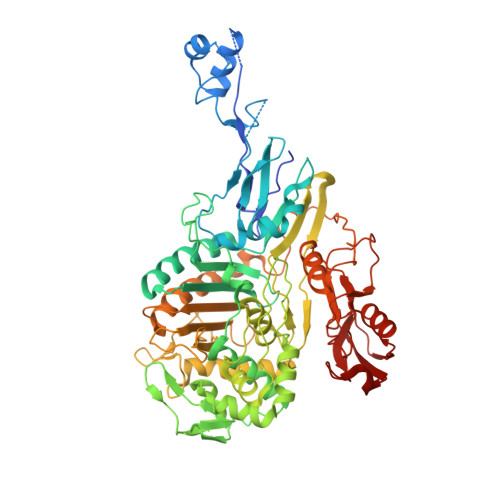The Structural Modifications Induced by the M339F Substitution in PBP2x from Streptococcus pneumoniae Further Decreases the Susceptibility to beta-Lactams of Resistant Strains
Chesnel, L., Pernot, L., Lemaire, D., Champelovier, D., Croize, J., Dideberg, O., Vernet, T., Zapun, A.(2003) J Biol Chem 278: 44448-44456
- PubMed: 12923202
- DOI: https://doi.org/10.1074/jbc.M305948200
- Primary Citation of Related Structures:
1PYY - PubMed Abstract:
PBP2x is a primary determinant of beta-lactams resistance in Streptococcus pneumoniae. Altered PBP2x with multiple mutations have a reduced "affinity" for the antibiotics. An important polymorphism is found in PBP2x sequences from clinical resistant strains. To understand the mechanism of resistance, it is necessary to identify and characterize the relevant substitutions. Many similar PBP2x sequences from resistant isolates have the previously studied T338A mutation, adjacent to the active site Ser337. We report here the structural and functional analysis of the M339F substitution that is found in a subset of these sequences, originating from highly resistant strains. The M339F mutation causes a 4-10-fold reduction of the reaction rate with beta-lactams, depending on the molecular context. In addition, release of the inactivated antibiotic from the active site is up to 3-fold faster as a result from the M339F mutation. These effects measured in vitro are correlated with the level of beta-lactam resistance in vivo conferred by several PBP2x variants. Thus, a single amino acid difference between similar PBP2x from clinical isolates can strongly modulate the degree of beta-lactam resistance. The crystal structure of the double mutant T338A/M339F solved to a resolution of 2.4 A shows a distortion of the active site and a reorientation of the hydroxyl group of the active site Ser337, which can explain the kinetic effects of the mutations.
Organizational Affiliation:
Laboratoire d'Ingénierie des Macromolécules, Institut de Biologie Structurale J.-P. Ebel (CEA/CNRS/UJF UMR 5075), 38027 Grenoble, France.

















